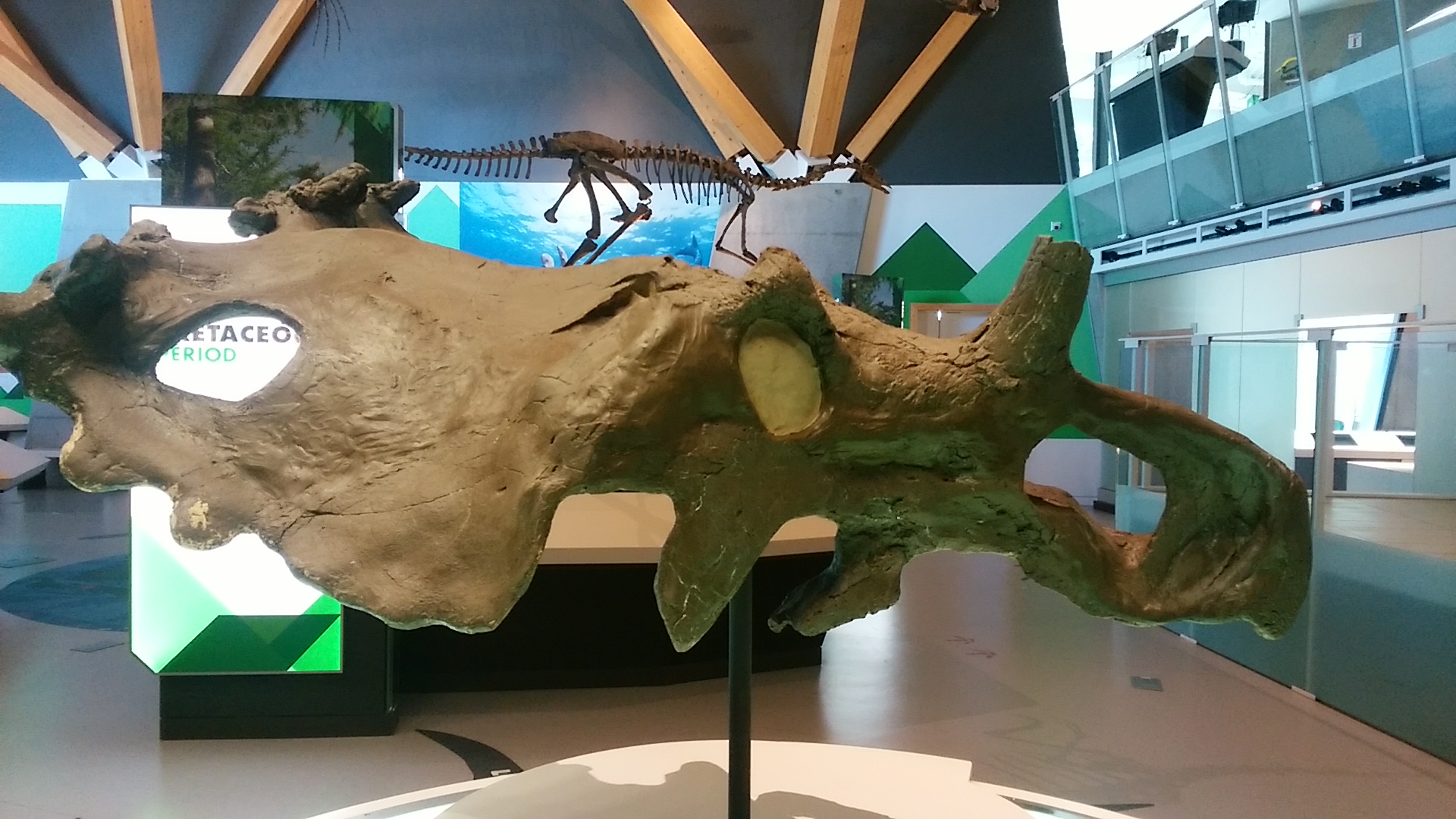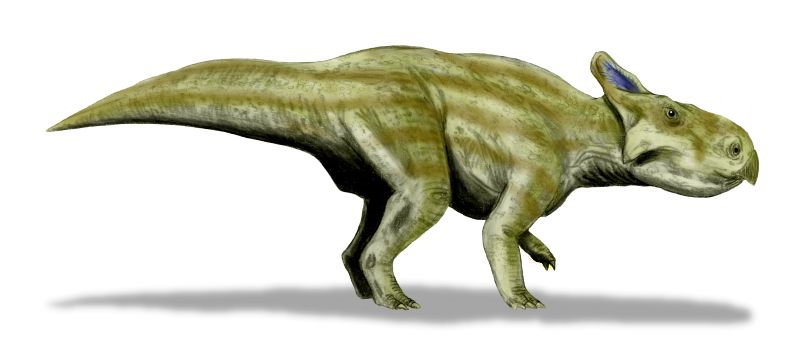|
Coronosaurus
''Coronosaurus'' is a genus of centrosaurine ceratopsian dinosaurs which lived in the Late Cretaceous, in the middle Campanian stage. Its remains, two bone beds, were discovered by Phillip J. Currie in the Oldman Formation of Alberta, Canada, and its type and only species, ''Coronosaurus brinkmani'', was first described in 2005, as a new species within the genus ''Centrosaurus''. Later studies questioned the presence of a direct relationship, and in 2012 it was named as a separate genus. ''Coronosaurus'' means "crowned lizard", coming from "''corona''", Latin for crown, and "''sauros''", Greek for lizard; this name refers to the unique, crown-like shape of the horns on the top of its frill. Like other ceratopsids, ''Coronosaurus'' had a large frill and horns on its head. These include a small pair of brow horns over its eyes, a large nasal horn on its snout, and, unique among ceratopsians, irregular, spiky bone masses on its frill. Growing up to around long and in weight, i ... [...More Info...] [...Related Items...] OR: [Wikipedia] [Google] [Baidu] [Amazon] |
Centrosaurine
Centrosaurinae (from the Greek, meaning "pointed lizards") is a subfamily of ceratopsid, a group of large quadrupedal ornithischian dinosaur. Centrosaurine fossil remains are known primarily from the northern region of Laramidia (modern day Alberta, Montana, and Alaska) but isolated taxa have been found in China and Utah as well. Defining features of centrosaurines include a large nasal horn, short supratemporal horns, and an ornamented frill projecting from the back of the skull. With the exception of ''Centrosaurus apertus'', all adult centrosaurines have spike-like ornaments midway up the skull. Morphometric analysis shows that centrosaurines differ from other ceratopsian groups in skull, snout, and frill shapes. There is evidence to suggest that male centrosaurines had an extended period of adolescence, and sexual ornamentation did not appear until adulthood. Centrosaurinae was named by paleontologist Lawrence Lambe in 1915, with ''Centrosaurus'' as the type genus. It is defi ... [...More Info...] [...Related Items...] OR: [Wikipedia] [Google] [Baidu] [Amazon] |
Oldman Formation
The Oldman Formation is a stratigraphic unit of Late Cretaceous (Campanian stage) age that underlies much of southern Alberta, Canada. It consists primarily of sandstones that were deposited in fluvial channel and floodplain environments. It was named for exposures along the Oldman River between its confluence with the St. Mary River and the city of Lethbridge, and it is known primarily for its dinosaur remains and other fossils.Eberth, D.A. and Hamblin A.P. 1993. Tectonic, stratigraphic, and sedimentologic significance of a regional discontinuity in the upper Judith River Group (Belly River wedge) of southern Alberta, Saskatchewan, and northern Montana. Canadian Journal of Earth Sciences 30: 174-200. Lithology The Oldman Formation is composed primarily of light-colored, fine-grained sandstones. They are upward-fining, lenticular to sheet-like bodies that are yellowish, steep-faced and blocky in outcrop. The formation also includes lesser amounts of siltstone and mudstone. ... [...More Info...] [...Related Items...] OR: [Wikipedia] [Google] [Baidu] [Amazon] |
Centrosaurus
''Centrosaurus'' ( ; ) is a genus of centrosaurine ceratopsian dinosaur from Campanian age of Late Cretaceous Canada. Their remains have been found in the Dinosaur Park Formation, dating from 76.5 to 75.5 million years ago. Discovery and naming The first ''Centrosaurus'' remains were discovered and named by paleontologist Lawrence Lambe in strata along the Red Deer River in Alberta. The name ''Centrosaurus'' means "pointed lizard" (from Greek ', , "point" and ', , "lizard") and refers to, the series of small hornlets placed along the margin of their frills, not the nasal horns (which were unknown when the dinosaur was named). The genus is not to be confused with the stegosaur ''Kentrosaurus'', the name of which is derived from the same Greek word. Later, vast bonebeds of ''Centrosaurus'' were found in Dinosaur Provincial Park, also in Alberta. Some of these beds extend for hundreds of meters and contain thousands of individuals of all ages and all levels of completion. Sc ... [...More Info...] [...Related Items...] OR: [Wikipedia] [Google] [Baidu] [Amazon] |
Spinops
''Spinops'' is an extinct genus of centrosaurine ceratopsian dinosaur from the Late Cretaceous of Alberta, southern Canada. It was a medium-sized ceratopsian, reaching in length and in body mass. Discovery and naming ''Spinops'' is known from the holotype NHMUK PV R 16307, a partial parietal bone, preserving most of the midline bar. Referred material include NHMUK PV R 16308, a partial parietal bone, partial dentary and unidentifiable limb fragments, NHMUK PV R 16306, an incomplete skull, preserving only the dorsal portion of the skull, and NHMUK PV R 16309, a partial right squamosal. None of this material was found in articulation, however it was all closely associated in the same bone bed, in the northwestern region ("Steveville Badlands") of the Dinosaur Provincial Park. Fossils of ''Spinops'' were first found in 1916, and were housed in the Natural History Museum in London. The material was not described until 2011, when the new species ''Spinops stern ... [...More Info...] [...Related Items...] OR: [Wikipedia] [Google] [Baidu] [Amazon] |
Rubeosaurus
''Styracosaurus'' ( ; meaning "spiked lizard" from the Ancient Greek / "spike at the butt-end of a spear-shaft" and / "lizard") is an extinct genus of herbivorous ceratopsian dinosaur from the Late Cretaceous (Campanian stage) of North America. It had four to six long parietal spikes extending from its neck frill, a smaller jugal horn on each of its cheeks, and a single horn protruding from its nose, which may have been up to long and wide. The function or functions of the horns and frills have been debated for many years. ''Styracosaurus'' was a relatively large dinosaur, reaching lengths of and weighing about . It stood about tall. ''Styracosaurus'' possessed four short legs and a bulky body. Its tail was rather short. The skull had a beak and shearing cheek teeth arranged in continuous dental batteries, suggesting that the animal sliced up plants. Like other ceratopsians, this dinosaur may have been a herd animal, travelling in large groups, as suggested by bone beds. Na ... [...More Info...] [...Related Items...] OR: [Wikipedia] [Google] [Baidu] [Amazon] |
Dinosaur Provincial Park
Dinosaur Provincial Park is a UNESCO World Heritage Site situated 220 kilometres (137 mi) east of Calgary, Alberta, Canada; or northeast of Brooks. The park is situated in the Red Deer River valley, which is noted for its striking badland topography, and abundance of dinosaur fossils. The park is well-known for being one of the richest dinosaur fossil locales in the world. Fifty-eight dinosaur species have been discovered at the park and more than 500 specimens have been removed and exhibited in museums around the globe. The renowned fossil assemblage of nearly 500 species of life, from microscopic fern spores to large carnivorous dinosaurs, justified its becoming a World Heritage Site in 1979. Dinosaur Provincial Park Visitor Centre The Dinosaur Provincial Park Visitor Centre features exhibits about dinosaurs, fossils, and the geology and natural history of the park. There is a video theatre, fossil prep lab area, and a gift shop. Public programs are offered in the summer. ... [...More Info...] [...Related Items...] OR: [Wikipedia] [Google] [Baidu] [Amazon] |
Bone Bed
A bone bed is any Geology, geological stratum or deposition (geology), deposit that contains bones of whatever kind. Inevitably, such deposits are Sedimentary rock, sedimentary in nature. Not a formal term, it tends to be used more to describe especially dense collections such as Lagerstätte. It is also applied to brecciated and Stalagmite, stalagmitic deposits on the floor of caves, which frequently contain osseous remains. In a more restricted sense, the term is used to describe certain thin layers of bony fragments, which occur in well-defined geological strata. One of the best-known of these is the Ludlow Bone Bed, which is found at the base of the Downton Sandstone in the Ludlow Group, Upper Ludlow series. At Ludlow (England) itself, two such beds are actually known, separated by about . of strata. Although quite thin, the Ludlow Bone Bed can be followed from that town into Gloucestershire, for a distance of . It is almost completely made up of fragments of Spine (zoology), s ... [...More Info...] [...Related Items...] OR: [Wikipedia] [Google] [Baidu] [Amazon] |
Belly River Group
The Belly River Group is a stratigraphic unit of Late Cretaceous age in the Western Canadian Sedimentary Basin. It takes the name from the Belly River, a tributary of the Oldman River in southern Alberta, and was first described in outcrop on the banks of the Oldman River (at the time considered part of the Belly River) and Bow River by George Mercer Dawson in 1883.Dawson, G.M., 1883. Preliminary report on the geology of the Bow and Belly river region, Northwest Territory, with special reference to the coal deposits. Geological Survey of Canada, Report of Progress for 1880-81-82, Part B. Lithology The Belly River Group is composed of very fine grained sandstone with coarse grained beds and minor bentonite, coal, green shale, and concretionary beds. Hydrocarbon production Gas is produced from the Belly River Group in the Deep Basin, in west-central Alberta and in the Canadian Rockies foothills. Paleofauna Dinosaur remains are among the fossils that have been recovered from ... [...More Info...] [...Related Items...] OR: [Wikipedia] [Google] [Baidu] [Amazon] |
Late Cretaceous
The Late Cretaceous (100.5–66 Ma) is the more recent of two epochs into which the Cretaceous Period is divided in the geologic time scale. Rock strata from this epoch form the Upper Cretaceous Series. The Cretaceous is named after ''creta'', the Latin word for the white limestone known as chalk. The chalk of northern France and the white cliffs of south-eastern England date from the Cretaceous Period. Climate During the Late Cretaceous, the climate was warmer than present, although throughout the period a cooling trend is evident. The tropics became restricted to equatorial regions and northern latitudes experienced markedly more seasonal climatic conditions. Geography Due to plate tectonics, the Americas were gradually moving westward, causing the Atlantic Ocean to expand. The Western Interior Seaway divided North America into eastern and western halves; Appalachia and Laramidia. India maintained a northward course towards Asia. In the Southern Hemisphere, Aus ... [...More Info...] [...Related Items...] OR: [Wikipedia] [Google] [Baidu] [Amazon] |
Philip J
Philip, also Phillip, is a male name derived from the Greek (''Philippos'', lit. "horse-loving" or "fond of horses"), from a compound of (''philos'', "dear", "loved", "loving") and (''hippos'', "horse"). Prominent Philips who popularized the name include kings of Macedonia and one of the apostles of early Christianity. ''Philip'' has many alternative spellings. One derivation often used as a surname is Phillips. The original Greek spelling includes two Ps as seen in Philippides and Philippos, which is possible due to the Greek endings following the two Ps. To end a word with such a double consonant—in Greek or in English—would, however, be incorrect. It has many diminutive (or even hypocoristic) forms including Phil, Philly, Phillie, Lip, and Pip. There are also feminine forms such as Philippine and Philippa. Philip in other languages * Afrikaans: Filip * Albanian: Filip * Amharic: ፊሊጶስ (Filip'os) * Arabic: فيلبس (Fīlibus), فيليبوس ( ... [...More Info...] [...Related Items...] OR: [Wikipedia] [Google] [Baidu] [Amazon] |








